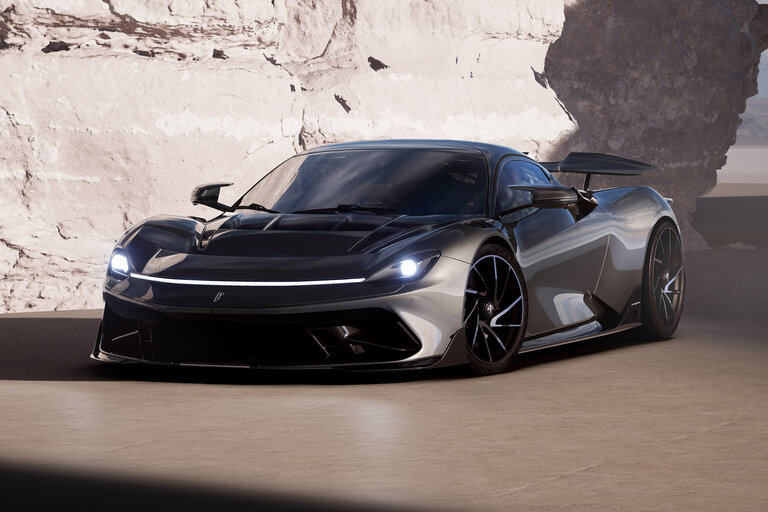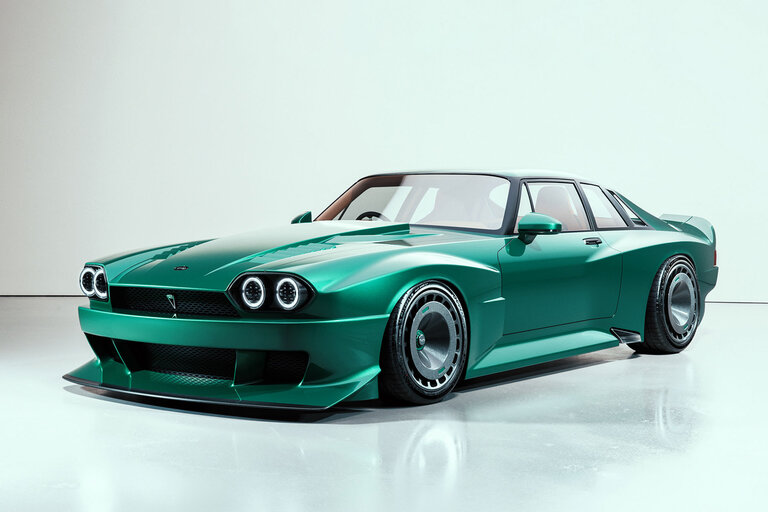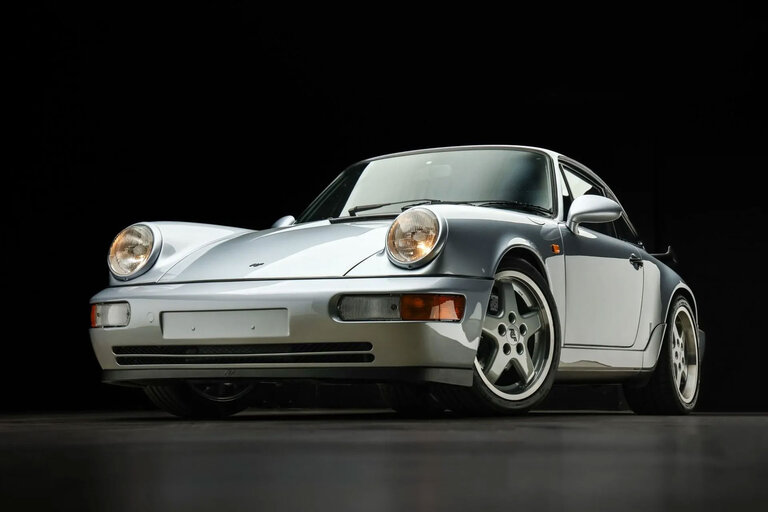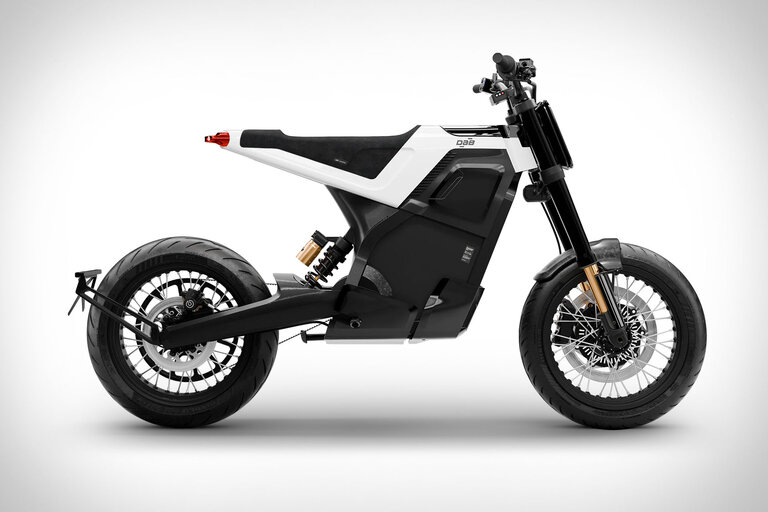
From the June 1997 issue of Car and Driver.
Don’t look now, but the wood-and-leather-lined halls of luxury sport-ute-dom have been invaded by a ruffian. It’s an ugly, uncultured, loud, smelly brute utterly lacking in social graces. This four-wheel-drive vehicle was not conceived as a shooting brake for swells on safari (although plenty of outgoing ordnance has been fired off its flanks). Nor does it wear a haughty German or Japanese nameplate.
No, this social climber climbed right off the battlefield, hosed off, changed into civvies, and rolled onto Rodeo Drive. Of course, we’re talking about AM General’s Hummer, the vehicular star of the Gulf War, roughly 7000 of which have now been sold wearing civilian colors. The first two Hummers we tested (C/D, July 1992 and June 1995) were such unpleasant and unwieldy conveyances on pavement that we naturally assumed they would be sold primarily to folks who intended to use them to roam their 1000-acre estates or go exploring for oil or perhaps to invade weak neighboring counties.
But AM General’s own market research confirms that poseurs are buying the lion’s share of this sport-ute, too. Forty-two percent of its buyers are identified in market lingo by AM General as “discerners.” These connoisseurs of fine wine, art, and travel are least interested in taking the Hummer off-road. Another 28 percent—described as “conquerors”—value the exclusivity of the Hummer and the attention it gets over its technical merits. Only 25 percent of owners—known as “realists” and “adventurers”—claim to have purchased the Hummer primarily for its off-road talents. (The remainder are sold for commercial duty.)
Has the Hummer been thoroughly domesticated in the past two years, or are most buyers just nuts? To find out, we spent a week in a 1997 Hummer.
Once again, our test vehicle was a four-passenger hardtop model priced at $63,827 to start (that’s up from $44,000 in 1992). The most popular model is the wagon, which starts at $67,111. The basic two-passenger model is yours for as little as $52,597. Must-have options—like central tire inflation and deflation, a winch, and driveline skid plating—can add up quickly, as our $84,502 sticker attests.
A new 6.5-liter turbo-diesel engine adapted from those that power GM’s new full-size vans has been added to the options list at a cost of $4523. It makes 195 horsepower at its 3400-rpm redline and 430 pound-feet of torque at 1800 rpm. A 170-horsepower, 290-pound-foot, 6.5-liter normally aspirated diesel engine is standard. The 5.7-liter gas engine has been dropped. The turbocharger resides in the valley at the rear of the engine, which allows this turbo-diesel to fit between the Hummer’s narrow frame rails, unlike those diesels with side-mounted turbos. The engine starts quickly (after a 10-second pause spent waiting for the glow plugs to warm the prechambers) but clatters like a big rig. Getting to 60 mph takes 15.2 seconds, an improvement from 18.1 in the gasoline-powered Hummer and 21.7 in the old 6.2-liter diesel. Now, hurtling toward highway speed feels like it takes just a week instead of a month. Top speed has risen to a truly hair-raising 88 mph. We managed to get only nine miles to the gallon, but a new 17-gallon auxiliary fuel tank extends the range past 350 miles.
Other improvements include the addition of a fresh-air intake scoop and rear exhaust vents that improve climate-control airflow by 15 percent, and a new electrically heated windshield. These upgrades were aimed at alleviating an interior fogging problem in winter driving. The problem remains. If the temperature drops below 40 degrees Fahrenheit, you must continually reset the timed electric defrosters and endure the din of the defroster blower on full blast to preserve front and rear visibility. The side windows will still fog up.
A new sound-insulation package reduces interior noise a bit compared with previous diesel Hummers (the gas model was quieter), but conversation with the distant passengers over the 83-dBA racket at 70 mph still involves some hollering. Finally, the seats have been redesigned for improved durability and comfort, but they still produce saddle sores during long stints at the wheel, and lateral space is limited for those broad of beam.
Nothing about driving a Hummer on the pavement is terribly pleasant other than its ability to intimidate fellow motorists. The steering wheel feels like a loop of steel rebar covered with foam rubber, and it transmits not a jot of information about the road surface. Turn the wheel at all quickly, and you are immediately reminded of Sir Isaac Newton’s theory on the resistance of a 7580-pound brick to change direction. Take to a freeway off-ramp at anything above the posted speed, and the tall truck tires—good for just 0.63 g—will first understeer like they were made of piano wire and then suddenly lean over, resulting in a queasy squirm off the intended line. Beefy suspension bits can always be heard clunking and banging around far beneath the driver’s seat, and they transmit plenty of pothole feel. One’s view of the right lane is never great, which makes passing and merging a bit tricky, and the flat side glass reflects disconcerting full-size virtual images of traffic passing on the opposite side of the vehicle. Similarly, the entire windshield becomes a rearview mirror at night.
Having duly noted all these objective criticisms, we organized a special final test: a poseur’s evening out to dinner and the theater in the Hummer. One of our guests, wearing a De Wolfe original mink coat, grumbled about the undignified climb into the back seat, but once aboard she was quite happy. On the way to the restaurant, we spied some gentle rolling mounds of frozen earth in a subdivision that was under construction. “Let me show you what this thing is really designed to do,” I heard the “discerner/conqueror” in me boast. I mentally plotted a course across a small dry pile of dirt near the road and headed toward it, not listening to the “adventurer/realist” inside, counseling me to first reconnoiter the path on foot.
As soon as the front wheels left the curb, they plunged through what looked like terra firma from the driver’s perch into a little ice-crusted ditch. I gave it a little throttle, but the wheels just spun. We had traveled precisely one foot off the road and gotten stuck. I engaged low range, locking the center differential, and pressed a dash-mounted switch to deflate the tires to 15 psi. Then I applied a bit of power in reverse. More mudslinging ensued, sans movement. The passengers were looking concerned. The rear tires couldn’t grip the snowy pavement, and the fronts were nearly hub-deep in wet mud. “I’m not pushing!” declared our nonplused mink-slung passenger. After five minutes spent gently rocking the mighty Hummer back and forth and sawing at the wheel to avoid deepening my ruts, the king of off-road vehicles managed to free itself.
Our social climber spent the duration of the weekend conquering Michigan’s semi-pavement, and we had our answer: 70 percent of Hummer buyers are nuts.
Specifications
Specifications
1997 AM General Hummer
Vehicle Type: front-engine, 4-wheel-drive, 4-passenger, 4-door pickup
PRICE
Base/As Tested: $63,827/$84,502
Options: 1GC option package (includes central tire-inflation system and run-flat tires, air conditioning, brush guards, driveline and rocker-panel protection, trailer-towing package, power windows, locks, and mirrors, cruise control, keyless entry), $11,366; 6.5-liter turbo-diesel engine, $4523; 12,000-pound winch, $2347; premium sound system with CD changer, $1461; heated windshield, $594; rear defroster, $384
ENGINE
turbocharged diesel V-8, iron block and aluminum heads
Displacement: 396 in3, 6478 cm3
Power: 195 hp @ 3400 rpm
Torque: 430 lb-ft @ 1800 rpm
TRANSMISSION
4-speed automatic
CHASSIS
Suspension, F/R: control arms/control arms
Brakes, F/R: 10.5-in vented disc/10.5-in vented disc
Tires: Goodyear Wrangler MT
37 x 12.5R-16.5
DIMENSIONS
Wheelbase: 130.0 in
Length: 190.5 in
Width: 86.5 in
Height: 75.0 in
Passenger Volume, F/R: 60/55 ft3
Curb Weight: 7580 lb
C/D TEST RESULTS
30 mph: 3.9 sec
60 mph: 15.2 sec
1/4-Mile: 19.9 sec @ 67 mph
80 mph: 37.0 sec
Rolling Start, 5–60 mph: 15.3 sec
Top Gear, 30–50 mph: 7.1 sec
Top Gear, 50–70 mph: 12.6 sec
Top Speed (drag ltd): 88 mph
Braking, 70–0 mph: 241 ft
Roadholding, 300-ft Skidpad: 0.63 g
C/D FUEL ECONOMY
Observed: 9 mpg
EPA FUEL ECONOMY
City/Highway: 13/17 mpg
#General #Hummer #Full #Metal #Racket
Source link





